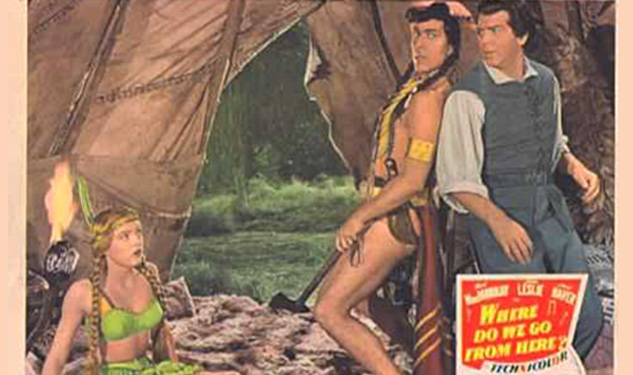
- Industry
Lost Musical Emerges from Hollywood’s Memory Banks
The HFPA’s resident musical historian Phil Berk uncovers a “lost” Fox gem scored by Kurt Weill
As an avid collector of Broadway musical LPs, in 1955 I happened upon a rare recording of songs written by Kurt Weill for a long forgotten 20th Century Fox musical called Where Do we Go From Here? The recording boasted one unforgettable number entitled The Nina, the Pinta, the Santa Maria. Not only were the lyrics (by Ira Gershwin) nimble and witty, but the melodies were instantly hummable.
I waited some thirty years, after having established a relationship with Fox Home Video, to implore them to release the film on DVD, but to no avail. My enthusiasm fell on deaf ears and I considered it a lost cause – until recently when the film was shown on the FX cable network. Finally I would get a chance to see the film.
Regrettably, the Technicolor has not been re-mastered, as was done for the Betty Grable musicals, but that didn’t diminish the quality of the writing or the vibrancy of the
musical numbers. The screenplay is the work of the estimable Morrie Ryskind, who won a Pulitzer prize for his collaboration with George and Ira Gershwin and George S. Kaufman on Of Thee I Sing, the first musical to win a Pulitzer. Ryskind, of course, had written many Marx Brothers theatre and Hollywood classics (among them Animal Crackers and The Cocoanuts) but earned the scorn of the creative community when he appeared as a friendly witness before the House un-American Activities sub-committee, and remained unrepentant until his dying day.
Weill, untarnished, died in 1950. His previous collaboration with Ira Gershwin was Lady in the Dark, a huge success that ran for over a year on Broadway. I can only assume that as a lark the two of them were recruited to write the songs for Where Do We Go From Here? , which was the brainchild of Ryskind and Sig Herzig.
Not much is known about when the film went into production. It was made at a time when Darryl F Zanuck was off winning the war for Hollywood, and the studio was being run by Louis B. Mayer’s son in-law William Goetz, whom Zanuck detested.
When Zanuck returned postwar, Goetz left the studio, and as an independent ended up producing such hits as Brando’s Sayonara.
Whether Zanuck would have sanctioned Where Do We Go From Here? is open to conjecture. The movie, a satirical fantasy, was not high on the studio’s priorities and in fact it ended up a box office and critical failure. But now 70 years later it deserves to be acknowledged as one of the best musicals of that era of great Hollywood Musicals. Few of those musicals have the vitality, the wit, and above all a story line built entirely around its songs. The casting itself was unorthodox. Instead of using a Don Ameche, the studio borrowed Fred MacMurray from Paramount. MacMurray had just come off Double Indemnity, his first serious role, but he is used here not as a comedian, which he was, but as a bona fide singer. His costars are contract player June Haver, whom he later married, and Joan Leslie, another loan out, but from Warner Bros., fresh from her success in Cagney’s Yankee Doodle Dandy. Anthony Quinn in a thankless role is almost unrecognizable.
The producer is William Perlberg who ended a distinguished career unfairly upstaged by his writer-director collaborator George Seaton. Perlberg too was coming off a huge success, The Song of Bernadette, which had won the first Golden Globe as best picture. But his true inspiration was assigning Gregory Ratoff to direct the film. Ratoff was a contract director at the studio, unjustly remembered today as the puppy dog producer Max Fabian in All About Eve. But during the thirties and forties he had an imposing career working at three different studios (Fox, MGM and Columbia) directing the likes of Ingrid Bergman, Orson Welles, Loretta Young and Robert Morley.
The whole enterprise was no doubt intended to bolster the war effort. MacMurray plays a rejected draftee desperate to get into some branch of the service. The plot involving a genie in a bottle is preposterous. But what makes it all work is Ratoff’s direction of the musical number. Granted, he had brilliant material to work with. Besides The Nina, the Pinta, the Santa Maria there are three other memorable songs, the rousing Morale, the obligatory love song All at Once, and the delightful Song of the Rhineland, which matches the Columbus song in its brilliant use of rhymes and catchy melodies (surprisingly sung by MGM character actor Herman Bing, a closet Nazi who returned to Germany after the war but survives as a fixture of early MGM musicals.) Otto Preminger too makes an unbilled appearance in
this number.
And so, to the short list of Hollywood’s most memorable original score musicals, alongside Mamoulian’s Love Me Tonight with its Rodgers and Hart songs Astaire and Rogers’s Top Hat (with Irving Berlin’s best score), I now submit Ratoff’s Where Do We Go from Here? A lost treasure that deserves your attention.
Philip Berk

